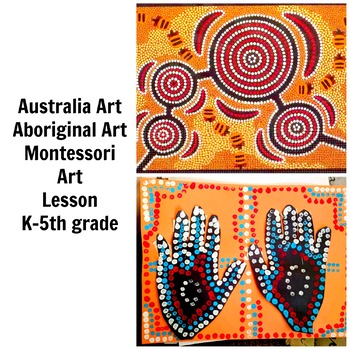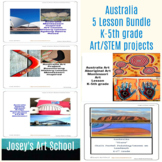Australia Aboriginal Art Lesson Montessori Grade K-5 Painting Lesson Common Core
- PDF
Also included in
- Attention Montessori and Elementary Teachers! Are you looking for a fun and engaging way to teach your students about Australia? Look no further than our Australia Theme 5 Art STEM Lessons Bundle, which includes easy-to-follow geography projects and stand-alone art lessons.Our bundle includes five uPrice $11.99Original Price $15.95Save $3.96
Description
If you're looking for an engaging and culturally rich art history lesson and project for your students, consider an Australian Aboriginal Art Lesson. This lesson will introduce your students to the rich cultural heritage of Aboriginal art and help them develop an appreciation for the unique techniques and styles used in this art form.
Here are some reasons why you should consider using an Australian Aboriginal Art Lesson in your classroom:
- Explore a unique art form: Aboriginal art is a unique art form that has a rich history and cultural significance. By introducing your students to this art form, you can help them develop an appreciation for diverse cultures and traditions.
- Teach about symbolism: Aboriginal art is rich in symbolism, and the images used in these artworks often have specific meanings. By studying these symbols, your students can learn about the cultural and spiritual beliefs of the Aboriginal people.
- Encourage creativity: Aboriginal art is known for its bold colors, geometric shapes, and intricate designs. By creating their own artworks inspired by Aboriginal art, your students can explore their own creativity and develop their own unique styles.
- Discuss the creative process: Use the Aboriginal art lesson as an opportunity to discuss the creative process with your students. Talk about how Aboriginal artists use different techniques and materials to create their work, and encourage your students to reflect on their own creative process as they create their own artworks.
- Showcase student work: Once your students have completed their Aboriginal art projects, display them in the classroom or school art gallery. This can be a great way to showcase your students' creativity and encourage them to continue exploring different artistic styles.
By using an Australian Aboriginal Art Lesson in your classroom, you can help your students develop an appreciation for diverse cultures and traditions while also exploring their own creativity. These lessons can serve as a springboard for discussions about history, culture, and self-expression.
IN THIS LESSON:
Artist: Montessori Australia Art
Painting: Aboriginal Art
-Copy of the original painting(s)
-biography of the artist/art
-questions to ask your students to engage the painting
-FULL COLOR AND THOROUGH step by step instructions written by an AMI Montessori trained Primary teacher.
CLICK HERE to view my freebies
CLICK HERE to view my 3 BUNDLED LESSONS
CLICK HERE to view my 5 BUNDLED LESSONS
Make sure to click the GREEN STAR near my store name so that you can stay in touch with my store. I create new lessons every week.



